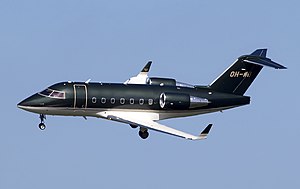| Challenger 600/601/604/605/650 | |
|---|---|
 A Bombardier CL-604 | |
| General information | |
| Type | Business jet |
| Manufacturer | Canadair Bombardier Aerospace |
| Status | In production |
| Number built | 1,066 (October 2018)[1] |
| History | |
| Manufactured | 1980–present[1] |
| First flight | 8 November 1978 |
| Developed into | Bombardier CRJ100/200 Bombardier Global Express |
The Bombardier Challenger 600 series is a family of business jets developed by Canadair after a Bill Lear concept, and then produced from 1986 by its new owner, Bombardier Aerospace. At the end of 1975, Canadair began funding the development of LearStar 600, and then bought the design for a wide-cabin business jet in April 1976. On 29 October, the programme was launched, backed by the Canadian federal government, and designed to comply with new FAR part 25 standards.
In March 1977, it was renamed the Challenger 600 after Bill Lear was phased out, and the original conventional tail was changed for a T-tail among other developments. The first prototype was rolled out on 25 May 1978, and performed its maiden flight on 8 November. The flight test program saw a deadly crash on 3 April 1980, but Transport Canada approved the CL-600 type certification on 10 August 1980.
In 1986, Canadair was close to bankruptcy and was bought by Bombardier. The jet was later stretched into the Bombardier CRJ regional airliner, introduced on 19 October 1992, and the longer range Global Express, introduced in July 1999. The 500th Challenger was rolled out in May 2000, and the 1000th was delivered to NetJets in December 2015. By October 2018, 1,066 aircraft had been built.
The Challenger is a low-wing jet powered by two turbofans mounted in aft fuselage pods, with a supercritical wing and a stand-up cabin with two seating sections. The original Lycoming ALF 502 turbofans were replaced by a pair of General Electric CF34s on the CL-601, which also gained winglets, and first flew on 10 April 1982. Subsequent variants have updated systems, avionics, and higher weights.
- ^ a b Murdo Morrison (12 October 2018). "NBAA: Business jet designs that changed the industry". FlightGlobal.